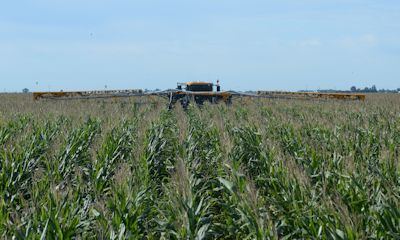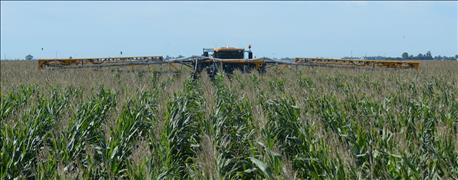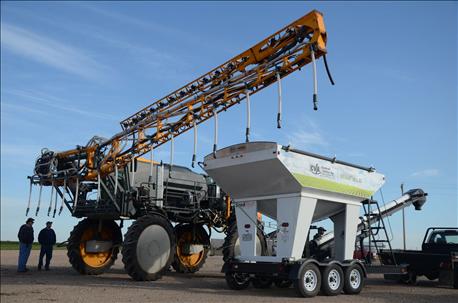
If you're a farmer interested in improving soil health or a cattle producer looking for a high-quality forage option, you'll want to check out the combine demonstration fields at Husker Harvest Days. Hagie Manufacturing has used a high-clearance STS applicator equipped with the CCI Cover Crop Interseeder option to plant a strip of cover crops into a demo field for every day of the show. This way, visitors can see the green growth of the six-way cover crop blend, including rye, oats, turnips, daikon forage radish, rapeseed, and red clover, each day after corn is harvested.

COVER CROPS AT HHD: Last week, Hagie used a high-clearance STS applicator equipped with the CCI to plant a six-way cover crop blend, including rye, oats, turnips, daikon forage radish, rapeseed, and red clover.
Cover crops have garnered a lot of interest in recent years, and Quentin Cooksley, Hagie Western Regional Sales Manager covering Nebraska, says this will give visitors a glance at a way to establish cover crops and gain an additional use out of Hagie applicators. "I think growers are asking, 'how can we take the best care of our soils, how can we increase yields, how can we be more efficient in how we feed our livestock?'" Cooksley says. "It really boils down to growers looking at farming more intensively and efficiently, and improving soil health at the same time. With cover crops you're able to do both."
The CCI is available as an option on new STS applicators and as a kit compatible with 2007 and newer STS models. It is available with 60-foot booms, and is customizable with different lengths of weighted drop tubes hanging off the booms to deliver seed below the canopy. Liquid fertilizer or pesticide tanks are simply switched with Gandy dry boxes.
~~~PAGE_BREAK_HERE~~~

EARLY ESTABLISHMENT: One challenge farmers often face is getting cover crop growth before winter. The success of aerial seeding, which many farmers rely on for early establishment, depends on the pilot's schedule and how uniformly and accurately the pilot drops the seed. Meanwhile, the seed may not get through the canopy. Cooksley says the CCI gives growers an option to establish cover crops with more assurance.
One challenge farmers in Nebraska and anywhere north of I-70 often face is getting cover crop growth before winter. The success of aerial seeding, which many farmers rely on for early establishment, depends on the pilot's schedule and how uniformly and accurately the pilot drops the seed. Meanwhile, the seed may not get through the canopy. Cooksley notes the CCI is one way to get cover crops established with more assurance.
"The idea behind the CCI is to get better seed to soil contact below the canopy and quicker germination. We're seeing roughly 30% more efficient germination with the interseeder because it gets down below the canopy," Cooksley says. "Applying with an airplane, we've found a lot of seed gets caught in the canopy and never gets to the soil."
In September 2013, Hagie conducted trials on two fields in Indiana. One field was seeded with an annual ryegrass cover crop with an airplane, while the other was seeded with the CCI.

CCI AVAILABILITY: The CCI is available as an option on new STS applicators and as a kit compatible with 2007 and newer STS models. It is available with 60-foot booms, and is customizable with different lengths of weighted drop tubes hanging off the booms to deliver seed below the canopy. Liquid fertilizer or pesticide tanks are simply switched with Gandy dry boxes.
"I went out in late November and assessed the stands. The plane seeded 25 pounds per acre. By mistake, we seeded 18 pounds per acre with the CCI. Initially, I thought the trial wasn't going to give quality results, but when we started counting, we found we had 46 seedlings per square foot with the CCI, and 38 seedlings per square foot in the aerial-seeded field," says Rachel Halbach, Hagie staff agronomist. "We think we can get more seedlings at a lower rate of seeding compared to aerial seeding."
~~~PAGE_BREAK_HERE~~~
"If we can seed our cover crops while the cash crop is still in the field, we can get a longer growing season, we're getting more growth, and we get the maximum benefit from them," Halbach adds. "That's more time that we're keeping fields covered, holding the soil, increasing water infiltration, sequestering nutrients, and cattle producers have a tremendous benefit because we've got an additional forage."
Amber Kohlhaas, communications manager at Hagie Manufacturing, also manages a row crop and cow-calf operation with her family near Algona, Iowa, including high-quality market and breeding cattle for showing. Kohlhaas notes at a time when margins are tight and pasture rental rates are high, having a method to establish cover crops, whether for grazing, hay or silage, can be a cost-effective way for cattle producers to feed cattle.
This March, she and her husband, Jason, seeded 80 acres to peas and barley using the CCI. "We seeded them as a short-term cover crop. We cut it, turned it into silage and bagged it," Kohlhaas says. "We see it as a win-win. We had a window of opportunity to plant cover crops, increase our soil health, and with our cow calf operation, it gives us a great feed source. We've been here for five years, and as we've grown our herd, we've been looking into additional feed and forage options. With our show cattle herd, what we feed is taken very seriously."
To learn more, visit Hagie Manufacturing at Lot 337.
About the Author(s)
You May Also Like






